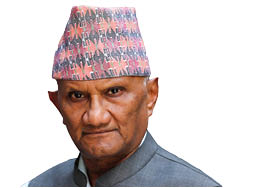With interest spread regulation and base rate mechanism in place, there is no incentive for BFIs to have lower cost of deposits, as the cost reduction is automatically passed on to borrowers and does not result in improved margins for BFIs.

Bank interest rates have become a topic of big debate in Nepal in recent years. It is obvious because changes in interest rates impact business operations and the lives of the general public. After a sharp increase in 2022, interest rates started to decline with the noticeable growth in liquidity in the financial system since the start of 2023. Even though the banking system is flushed with excess liquidity, interest rates have remained on the higher side due to various reasons.
Growth in deposits and loans
In the fiscal year 2022/23, loans and deposits of banks and financial Institutions (BFIs) increased by Rs 165 billion (3.5%) to Rs 4,879 billion, whereas deposits grew by Rs 608 billion (11.79%) to Rs 5,767 billion. In FY 2021/22, BFIs saw their loans grow by Rs 539 billion (12.92%) and deposits by Rs 419 billion (8.84%). Out of the total loan growth of Rs 539 billion during the FY 2021/22, the second half of the fiscal year saw loan growth of Rs 33 billion only, meaning credit growth during the period of the last 18 months up to Ashad 2080 (June-July 2023) was Rs 198 billion. The credit-to-deposit (CD) ratio of commercial banks as of the last fiscal year stood at 81.65 percent. On the basis that BFIs are permitted to lend up to the CD ratio of 90 percent, the additional lending capacity of the BFIs at the end of the fiscal year was almost Rs 500 billion. Considering the loan growth during the past 18 months and prevailing slackness in demand for credit, this additional lending capacity can easily be considered to be significant.
Interest rates, liquidity and credit demand
 Due to low credit demand and higher liquidity in terms of lendable sources as detailed earlier, interest rates have started falling for the last few months. The average interest rate on loans and the average cost of deposits and base rate peaked at 13.03 percent in Magh 2079 BS (January-February), 8.51 percent in Poush 2079 (December-January) and 10.91 percent in Poush 2079 respectively. These rates reduced to 12.3 percent, 7.86 percent and 10.03 percent respectively as of Ashad 2080. In light of comfortable liquidity in the economy, subdued credit demand and the Nepal Rastra Bank (NRB) lowering its policy rate from 7 percent to 6.5 percent in the monetary policy for FY 2023/24, most people expected that interest rates would continue to go down. To everyone’s surprise, more than half of commercial banks increased their fixed deposit rates with effect from August 18 (Ashwin 1).
Due to low credit demand and higher liquidity in terms of lendable sources as detailed earlier, interest rates have started falling for the last few months. The average interest rate on loans and the average cost of deposits and base rate peaked at 13.03 percent in Magh 2079 BS (January-February), 8.51 percent in Poush 2079 (December-January) and 10.91 percent in Poush 2079 respectively. These rates reduced to 12.3 percent, 7.86 percent and 10.03 percent respectively as of Ashad 2080. In light of comfortable liquidity in the economy, subdued credit demand and the Nepal Rastra Bank (NRB) lowering its policy rate from 7 percent to 6.5 percent in the monetary policy for FY 2023/24, most people expected that interest rates would continue to go down. To everyone’s surprise, more than half of commercial banks increased their fixed deposit rates with effect from August 18 (Ashwin 1).
Why BFIs increase interest rates despite a comfortable liquidity position with subdued credit demand?
There is a clear answer to this question. The answer is the resultant distortion of some NRB regulations relating to interest rates:
As per NRB regulation, BFIs can revise their interest rates on deposits on a monthly basis only, and they have to publish the rates before the commencement of the Nepali month. The only exception to this regulation is when NRB changes its bank and policy rates. Because of this regulation, there will be some fear amongst the BFIs that their deposits could be lost to other BFIs if their rates were lower. As per another NRB regulation, BFIs can change their rates at a maximum of 10 percent of their average existing rates in their respective categories. Because of the fear of losing the deposits, they tend to keep their interest rates on deposits on the higher side. Many commercial banks that reduced the interest rates on fixed deposits for the month of Shrawan (July-August) increased the rates on fixed deposits for the month of Ashwin (August-September) as they must have lost their deposits in Shrawan to banks with higher interest rates. I believe that this NRB regulation alone would encourage the BFIs to be in a high-interest rate regime. Needless to say, the higher cost of deposits would result in higher interest rates on loans.
Commercial Banks were required to bring down their average interest spread between interest rates on deposits and loans to 4 percent by Ashad 2080 (June-July). The central bank mandated development banks and finance companies were directed to bring down their spread rate to 4.6 percent by the deadline. Commercial banks that completed mergers and acquisitions by Poush 2079 (extended to Ashad 2080 subsequently) were permitted to have an additional 1% interest spread over the applicable rate for one year from the date of joint operation. In the last 12 months up to Ashad 2080, 14 commercial banks went for mergers and acquisitions to become seven commercial banks. Of these banks, Nabil Bank completed the exemption period for interest spread in Ashad and its interest spread rate was 4.99 percent then. The bank is required to reduce the spread rate to 4 percent from Shrawan onwards. In order to bring down the interest spread, the bank had three alternatives – increase the interest rate on deposits, decrease the premium rate to reduce lending interest rates, and use a combination of the two. The bank appears to have adopted the third alternative- largely increasing the interest rate on deposits as a premium over the base rate for loans cannot be increased again as per another NRB regulation if it is once reduced. In view of the situation, Nabil was forced to be in a higher interest rate regime. This has put pressure on other banks to follow suit. The exemption period for interest spread will expire for four banks in Poush 2080 (December-January 2024), one bank in Falgun 2080 (February-March 2024), and one bank in Ashad 2081 (June-July 2024).
As per another NRB regulation, BFIs cannot have an interest rate differential of more than 5 percent between minimum and maximum interest rates on local currency deposits with the exception of call and some other deposits. Because of this arrangement, the average interest rate on savings deposit was 5.81 percent as of Ashad 2080. In India, the interest rate on savings deposits ranges between 2.7 percent to 3 percent. Our savings deposit is no different from current accounts with no withdrawal and other restrictions. Large savings deposits, which are interest rate sensitive, are like call deposits. Banks are paying higher interest rates on vulnerable deposits as well.
With interest spread regulation and base rate mechanism in place, there is no incentive for BFIs to have lower cost of deposits, the largest component of the base rate, as the cost reduction is automatically passed on to borrowers and does not result in improved margins for BFIs.
The way forward
In Nepal, interest rates are indifferent to the policy rates prescribed by NRB. The central bank reduced the policy rate to 6.5 percent from 7 percent via the Monetary Policy for FY 2023/24. Instead of reducing the rates in line with the central bank’s decision, banks increased interest rates. A similar instance was seen last year when NRB hiked the policy rate by 1.5 percent to 7 percent in Monetary Policy for FY 2022/23, but the banks remained indifferent. As a result of moral pressure from NRB, banks increased their rates effective from Kartik 1 2079 (October 18, 2022), almost three months after NRB increased the policy rate.
In India, the Reserve Bank of India introduced a base rate mechanism effective from July 1, 2010, marginal cost of funds-based lending rate (MCLR) effective from April 1, 2016, and external benchmark-based lending rate (EBLR) effective from October 1, 2019. The effectiveness of monetary policy rate transmission has improved considerably since the introduction of EBLR in particular. Shares of outstanding floating rate rupee loans under base rate, MCLR, EBLR, and others were 10.3 percent, 78.3 percent, 9.1 percent, and 2.3 percent respectively in March 2020. The shares as of March 2023 stood at 3 percent, 45.5 percent, 49.6 percent, and 1.9 percent respectively. Under EBLR, lending interest rates are linked to repo/treasury bill rates (i.e. premium over the repo/TB rate). Like India, lending rates are linked to central bank rates in other markets as well resulting in effective transmission of changes in central bank rates.
NRB should review the entire interest rate mechanism in order to make the monetary policy transmission effective. It is time to phase out or replace the base rate in Nepal as well with EBLR. With this mechanism in place, interest rates will largely be under the control of NRB. NRB should also allow BFIs to publish interest rates at any time as per their requirement and market conditions. This will prevent BFIs from being too aggressive in publishing the deposit rates. The existing arrangement of interest spread regulation has penalized efficient banks. It should therefore be withdrawn immediately.
Chhetri is a financial consultant and is a former banker.


